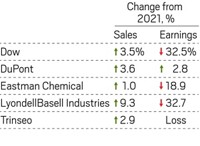Advertisement
Grab your lab coat. Let's get started
Welcome!
Welcome!
Create an account below to get 6 C&EN articles per month, receive newsletters and more - all free.
It seems this is your first time logging in online. Please enter the following information to continue.
As an ACS member you automatically get access to this site. All we need is few more details to create your reading experience.
Not you? Sign in with a different account.
Not you? Sign in with a different account.
ERROR 1
ERROR 1
ERROR 2
ERROR 2
ERROR 2
ERROR 2
ERROR 2
Password and Confirm password must match.
If you have an ACS member number, please enter it here so we can link this account to your membership. (optional)
ERROR 2
ACS values your privacy. By submitting your information, you are gaining access to C&EN and subscribing to our weekly newsletter. We use the information you provide to make your reading experience better, and we will never sell your data to third party members.
Finance
Supply chain problems hit chemical firms
Third-quarter financial results are strong versus a year earlier, but inflation and shipping threaten further progress
by Alexander H. Tullo
November 4, 2021
| A version of this story appeared in
Volume 99, Issue 41
Third-quarter financial results for major chemical companies show that the industry continues to rebound from the pandemic-induced economic slump of 2020. But new problems, namely inflation and supply chain snarls, are beginning to drag on performance.
Third-quarter results

The early reporters BASF and Dow both posted strong results year over year. But higher costs caused BASF’s earnings to slip from the second quarter and Dow’s to remain flat.
Firms that reported after those two large companies showed the same pattern. At the Belgian specialty chemical maker Solvay, sales rose 22% and earnings jumped 55% from the third quarter in 2020. Its sales to automotive, electronics, and building material markets were all up 25–30%. Sales to mining, consumer goods, and health-care customers increased 15–20%. Even Solvay’s aerospace materials unit—hard-hit by a freeze in aircraft orders due to travel restrictions—showed signs of a turnaround.
Solvay’s earnings fell 1% from the second quarter, however. The firm says its raw material, energy, and logistics costs have increased by nearly $250 million since the beginning of the year. Solvay is trying to raise prices to pass the additional costs to its customers.
In a call with stock analysts, Solvay CEO Ilham Kadri called the inflation “painful” and noted that it was “the first time in my career I have seen such a spike in such a short period of time.”
Eastman Chemical faced the same challenges. Selling prices in its chemical intermediates business increased 46% in the third quarter from a year earlier, but costs in Eastman’s specialties businesses rose by $400 million over the past 9 months because of higher prices for raw materials, energy, and distribution. Its specialty plastics unit has been constrained by logistics and has resorted to sending freight by air.
Matthias Zachert, CEO of the German chemical maker Lanxess, put a positive spin on the situation as the company reported quarterly profits more than double those of the same period one year earlier. “We successfully passed on the significantly increased raw material costs,” he said in an earnings announcement.
Suppliers of engineering polymers and polyurethanes continue to be beset by a slowdown in auto manufacturing. “Our global automotive business is being hindered by the chip-related shortages that are reducing automotive production,” Huntsman CEO Peter Huntsman told analysts. “We believe these challenges will eventually be worked out and that low inventories and strong underlying demand globally could drive higher production rates.”
Celanese says it made the best of a bad auto industry situation. CEO Lori Ryerkerk told analysts that third-quarter auto builds were down 12% from the second quarter but that the company’s sales volume to the sector fell only 1%. She credited higher sales of products such as materials for lithium-ion battery separators used in electric vehicles, a market that’s growing faster than the rest of the automotive industry.



Join the conversation
Contact the reporter
Submit a Letter to the Editor for publication
Engage with us on Twitter